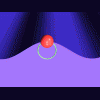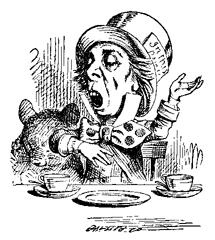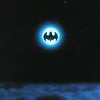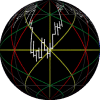
best indicator?
#21

Posted 30 August 2004 - 11:46 PM
#22

Posted 31 August 2004 - 02:37 AM
McCavity, Please explain to me why MCAD hist is a leading indicator and MCAD is a lagging indicator. It is my understanding MACD Hist is an other way of expressing MACD.
apologies for not replying earlier.
If we take an EMA as lagging.
The difference of two EMAs (a sort of derivative) - MACD- is faster.
The difference of the difference of two EMAs - MACDHisto - is faster still
By leading or lagging I mean it typically turns before or after price does.
Not that it crosses the zero/neutral line.
For MACD i use (8,21,13) but this is still true for the classical settings of (12,26,9).
-macavity
#23

Posted 31 August 2004 - 10:48 AM
I think one of the better indicators is a weekly MACD. Don't wait for a cross over the signal line, but rather just an upturn. 13 21 8.
First for those who may not know, lets explain (using SMA) the Moving Average Convergence/Divergence. MACDi is the difference between the 13-week SMAi (Simple Moving Average) of the closing prices and the 21-week SMAi of the closing prices. You say: go long if this calulation increases (turns up).. go short if it decreases (turns down).
Algebraically you are saying this:
if (13MA1 - 21MA1) > (13MA2 - 21MA2) is TRUE then go LONG (vice versa for SHORT)
Lets simplify...
13SMA1 = (c1+c2+c3 ... c13) / 13
21SMA1 = (c1+c2+c3 ... c21) / 21
likewise:
13SMA2 = (c2+c3+c4 ... c14) / 13
21SMA2 = (c2+c3+c4 ... c22) / 21
Plugging those formuala into your equation we get:
{(c1+c2...c13)/13 - (c1+C2...c21)/21} > {(c2+c3...c14)/13 - (c2+c3...c22)/21}
multiplying both sides by 13 gives:
{.381*(c1+c2+...c13) - .619*(c14+c15...c21)} > {.381*(c2+c3...c14) - .619*(c15+c16...c22)}
which can be reduced as follows:
.381*c1 - .619*c14 > .381*c14 - .619*c22
.381*c1 - .619*c14 + .619*c14 > .381*c14 +.619*c14 -.619*c22
.381*c1 > c14 - .619*c22
or
c1 > 2.624*c14 - 1.624*C22 <-- your simplified MACD system
So what you are saying is BUY if: this weeks close is greater than 2.624 times the close 14 weeks ago minus 1.624 times the close 22 weeks ago. Just the opposite is true for a SELL signal.
Personally I'm skeptical of such a system. What is so special about these weeks (1, 14 and 22) and that particular relationship? TA should have some logical basis. Please tell me...why should it should perform?
This analysis applies to all MACD regardless of parameters. I would like to see McCavity explain how one gets a "leading system" out of (potentially very) old price information. Now THAT would be a good trick!
#24

Posted 31 August 2004 - 11:35 AM
DMI is still the best all around indicator for all time frames including intraday.
Oh really! Lets look at DMI shall we.
DMI is based on positive and negative movement (assume 14 day): +DI14 and -DI14
Algebraically what you are saying is If +DI14 > -DI14 then buy
+DI14 is the ratio of two functions,
+DI14 = +DM14/TR14 where;
TR14 is the 14-day sum of the true price range and
+DM14 is the 14-day sum of the high price for the current day, H, minus the high price for the preceding day, H+1 or:
+DM14 = (H1-H2)+(H2-H3)+....+(H14-H15) = H1-H15 likewise
-DI14, is:
-DI14 =-DM14/TR14
and -DM14 is the 14-day sum of the low price, L, minus the low price for the preceding day, L+1...again simplifying gives:
-DM14 = L1 - L15
If we plug these +/-DM equations into the original inequality, we have:
(H1-H15)/TR14 > (L1-L15)/TR14
which simplifies to:
H1-H15 > L1-L15
Which can be further simplified by adding (H15-L1) to both sides which gives:
If H1-L1 > H15-L15 then buy
Again... I very skeptical of a system that says go long if today's price range is greater than the price range 15 days ago. Why should that matter? Where is the logic?
#25

Posted 31 August 2004 - 04:39 PM
#26

Posted 31 August 2004 - 05:14 PM
Again... I very skeptical of a system that says go long if today's price range is greater than the price range 15 days ago. Why should that matter? Where is the logic?
I try not to let LOGIC cloud my judgement...LOL This is the market...not a math exam.
I gave an answer based on what 1 indicator works best for me and I mainly Index trade. I never really tried to understand why...just like I never really tried to understand why it does SOOOOO much better on the weekly S&P and Naz and not the Dow.
I trade the mini's almost exclusively and nearly everyone of my systems is based mainly on DMI / ADX and moving averages and they work really well. That is all I based my reply on.
"Bottoms come fast...Tops take forever"
#27

Posted 31 August 2004 - 05:41 PM
Mark Young said:
I think one of the better indicators is a weekly MACD. Don't wait for a cross over the signal line, but rather just an upturn. 13 21 8.
So what you are saying is BUY if: this weeks close is greater than 2.624 times the close 14 weeks ago minus 1.624 times the close 22 weeks ago. Just the opposite is true for a SELL signal.
Personally I'm skeptical of such a system. What is so special about these weeks (1, 14 and 22) and that particular relationship? TA should have some logical basis. Please tell me...why should it should perform?
This analysis applies to all MACD regardless of parameters. I would like to see McCavity explain how one gets a "leading system" out of (potentially very) old price information. Now THAT would be a good trick!
Firstly, I'd like to say thanks for the in depth analysis of the mathematics behind the indicators. I'll freely admit that I no longer get into the indicators deeply enough to understand all the math that goes into them. I merely get my brain around what they measure and then observe them over time.
Just eyeballing the chart for the past year and 1/2, I see that you had what appears to be 6 good signals (2 weeks of action in the direction of the signal) and about 3 bad ones, and some real slop. Over time, I've found that it works pretty well, and it gives you a trend context for other trades.
It isn't a SYSTEM, though. Just a useful indicator for trading--one that improves the effective use of OTHER indicators.
Anyway, "WHY" it works isn't important. All that matters is that it does and is helpful.
Best,
Mark
Mark S Young
Wall Street Sentiment
Get a free trial here:
http://wallstreetsen...t.com/trial.htm
You can now follow me on twitter
#28

Posted 31 August 2004 - 05:44 PM
I posted weekly charts of a directional movement system applied to the S&P, Naz and Dow in the "backtesting pitfalls" thread just above this one so you can see the results for yourself. I will post some 3 minute charts here of today's action on the S&P, Naz and Dow e-mini's because that is what I trade. You can tell that chop is the worst enemy of the indicator (show me one that isn't) but all trends are picked up quick. I don't why it works but it does.
e-mini S&P
e-mini Naz
e-min Dow
"Bottoms come fast...Tops take forever"
#29

Posted 31 August 2004 - 05:48 PM
#30

Posted 31 August 2004 - 07:01 PM


















